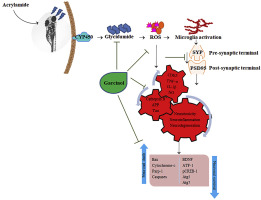Food and Chemical Toxicology ( IF 3.9 ) Pub Date : 2020-03-07 , DOI: 10.1016/j.fct.2020.111246 Chanchal Sharma , Sun Chul Kang

|
The presence of acrylamide (ACR) in food results in evident cognitive decline, accumulation of misfolded proteins, neurotoxicity, neuroinflammation, and neuronal apoptosis leading to progressive neurodegeneration. Here, we used 4 dpf zebrafish larvae exposed to ACR (1mM/3days) as our model, and neuronal proteins were analyzed. Next, we tested the effect of garcinol (GAR), a natural histone-acetylation inhibitor, whose neuroprotection mechanism of action remains to be fully elucidated. Our result revealed that ACR exposure significantly impaired cognitive behavior, downregulated oxidative repair machinery, and enhanced microglia-induced neuronal apoptosis. Moreover, ACR mediated cathepsin-B (CAT-B) translocation acted as the intracellular secretase for the processing of amyloid precursor protein (APP) and served as an additional risk factor for tau hyper-phosphorylation. Here, GAR suppresses ACR mediated CATB translocation as similar with standard inhibitor CA-074. And, this pharmacological repression helped in inhibiting amyloidogenic APP processing and downstream tau hyper-phosphorylation. GAR neuroprotection was accompanied by CREB, ATF1, and BDNF activation promoting neuronal survival. At the same time, GAR subdued cdk5 and GSK3β, the link between APP processing and tau hyper-phosphorylation. Taken together, our findings indicate that GAR rescued from ACR mediated behavioral defects, oxidative injury, neuroinflammation, undesirable APP processing, tau hyper-phosphorylation which in turn found to be CATB dependent.
中文翻译:

大蒜素通过调节斑马鱼幼虫大脑中的组织蛋白酶B调节GSK信号传导和pCREB的活化,从而缓解丙烯酰胺诱导的认知障碍,神经炎症和神经元凋亡。
食物中丙烯酰胺(ACR)的存在会导致明显的认知能力下降,蛋白质折叠错误,神经毒性,神经炎症和神经元凋亡,从而导致进行性神经变性。在这里,我们使用4 dpf斑马鱼幼虫暴露于ACR(1mM / 3天)作为模型,并分析了神经元蛋白。接下来,我们测试了藤黄素(GAR)的作用,这是一种天然的组蛋白乙酰化抑制剂,其神经保护作用机理尚待充分阐明。我们的结果表明,暴露于ACR会严重损害认知行为,下调氧化修复机制并增强小胶质细胞诱导的神经元凋亡。此外,ACR介导的组织蛋白酶B(CAT-B)易位充当淀粉样前体蛋白(APP)加工的细胞内分泌酶,并且是tau过度磷酸化的另一个危险因素。在这里,与标准抑制剂CA-074相似,GAR抑制ACR介导的CATB转运。并且,这种药理学抑制作用有助于抑制淀粉样蛋白原APP加工和下游tau过度磷酸化。GAR神经保护作用伴有CREB,ATF1和BDNF激活,从而促进神经元存活。同时,GAR抑制了cdk5和GSK3β(APP处理与tau超磷酸化之间的联系)。综上所述,我们的发现表明GAR可从ACR介导的行为缺陷,氧化损伤,神经炎症,不良的APP处理,











































 京公网安备 11010802027423号
京公网安备 11010802027423号